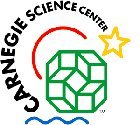  |
|||
|
|
|
|
|
  |
|||
|
|
|
|
|
SeaScape Gets New Underwater ThemesDon't panic. The third floor of the Carnegie Science Center only APPEARS to be underwater."We've created a thematic space where you feel like you are underwater," says Senior Exhibit Designer Pete Feher of the Science Center's upgraded SeaScape exhibit. With five aquarium tanks, faux coral covered walls, piped in sounds of whales and waves, and a model of a sunken 16th-century Spanish galleon, the illusion is remarkably real--and hard to wade away from. Newly added is a mangrove tank, representing the area of a coral reef where fish breed, 20-foot trees growing into the atrium gallery, computer kiosks for detailed information about the tanks' more than 400 species of animals and plants, and underwater cameras for close-ups. An even closer look is provided at the video microscope station where a microscope magnifies tank creatures 180 times their actual size. A 3-foot by 6-foot touch tank allows visitors to hold starfish, sea urchins, and horseshoe crabs. For something surreal, poke your head in the giant fish model called “See Like a Fish” and view the surroundings as if your eyes were positioned on either side of your head! Covered with barnacles and soaring to the 8-foot ceiling is the model of a 16th-century sunken Spanish galleon model. "It shows how a man-made object can become part of a coral reef," says Feher. Inside the ship is the ever-popular “Yellow Submarine,” upgraded with a buoyancy exhibit, and a play diving suit for the kids. Much of the exhibit's new look is the result of the design and construction talents of 34 Art Institute of Pittsburgh students, recruited by institute grad Feher. These student volunteers designed the galleon and protective coloration exhibit, spiffed up the Yellow Submarine, and sculpted the foam and fiberglass coral. So dive in! The water temperature’s always temperate here!
ZAP! Surgery Beyond the Cutting Edge Medical Marvels are a Personal Experience 340 / 2157 Not long ago a "surgical procedure" meant scalpels, sutures, and weeks of recovery. Not anymore. Today the trend is toward minimally invasive surgical technologies. Some of these technologies – lasers, endoscopes, the Gamma Knife, ultrasound, and cryosurgery – are the focus of Zap! Surgery Beyond the Cutting Edge. “These technologies were chosen because they provide a unique, exciting context for exploring basic science concepts often presented in science centers,” says Linda Ortenzo, project manager. Featuring bright, colorful modules and easy-to-understand text panels, Zap! Surgery’s interactives explain the science behind these surgical technologies. Video clips of real surgeries bring medicine to life, and activities allow visitors to perform simulated surgery. One of the most stunning components is a giant eyeball, which demonstrates one type of retina retinopathy. Visitors shoot a laser beam into the eye, simulating a procedure used to stop abnormal blood vessels from leaking fluid into the retina. “This is one of several activities that collectively illustrate the properties of laser light and explain how it interacts with body tissue,” says Patty Antalis, exhibit developer. Doctors, nurses, bioengineers, technicians, and a teacher advisory board served as consultants on the 6,000-square-foot, $2.2 million exhibit. "We spent a lot of time in development to make this fun and simplify the topic, but also to make it accurate," says Lauren Eckie, exhibit designer. And fun is what the Zap! Jr. component is all about. Developed for children ages five to eight, this section of Zap! Surgery features a huge reproduction of the game Operation.® Kids can don surgical scrubs and toy stethoscopes and use big tweezers to "operate" on Cavity Sam (yes, he does have a name). Also pure fun is ZapCam, a four-minute thrill ride that bumps and bounces the audience through a "ride" inside a human body. Phase I of Zap! Surgery is completed, but Phase II (lasers, cryosurgery,
Zap! Jr., and ZapCam) runs from mid-June to August 13. The exhibit
then moves to Cleveland's Great Lakes Science Center where it will be featured
as a part of the annual Association of Science and Technology (ASTC) conference
and will showcase Pittsburgh’s leadership in medical technology and healthcare.
Zap! returns to Pittsburgh as a total exhibition, opening February
2, 2001.
|
|
|
|
|
|
|
All rights reserved. E-mail: carnegiemag@carnegiemuseums.org |
|||